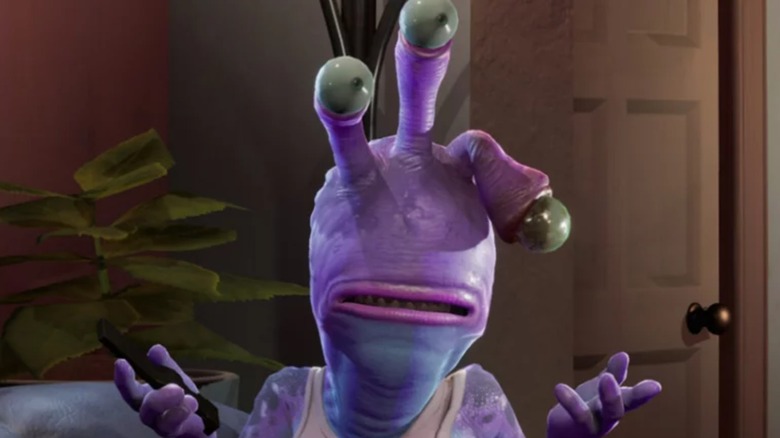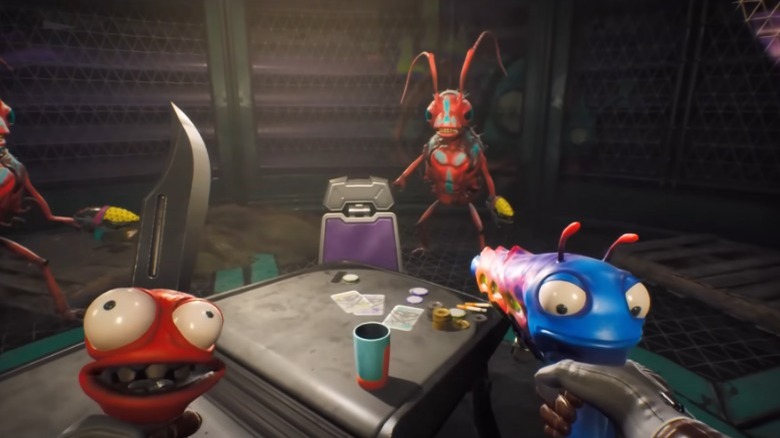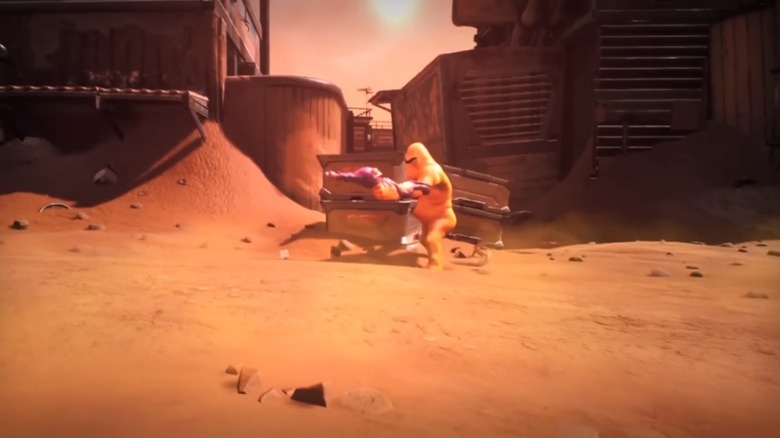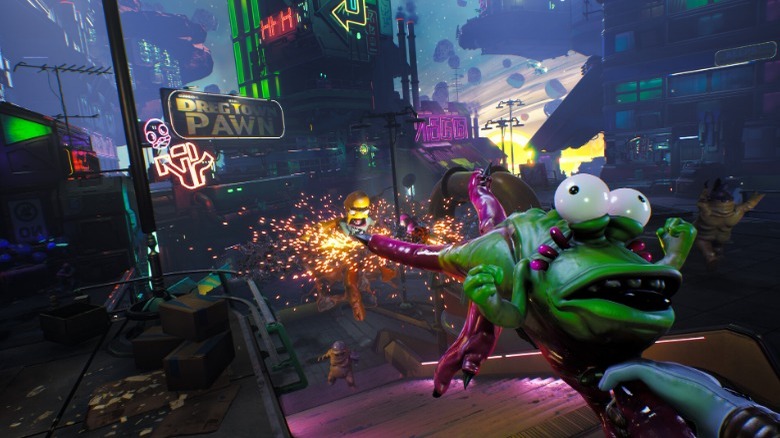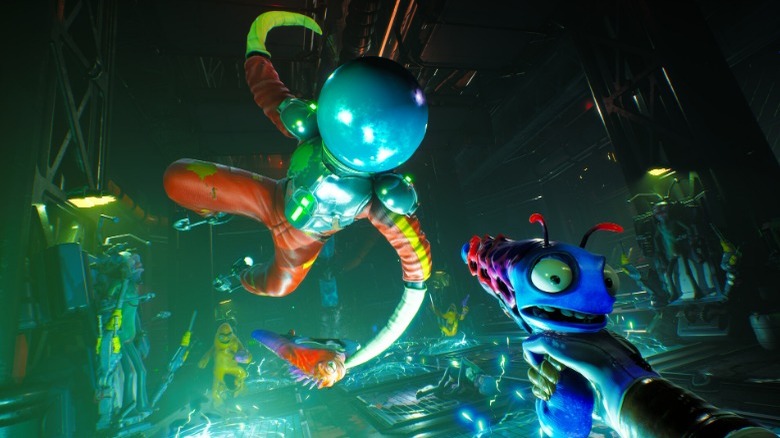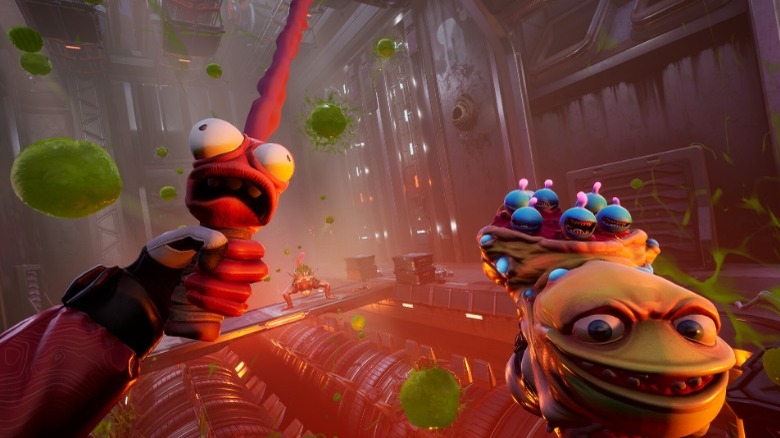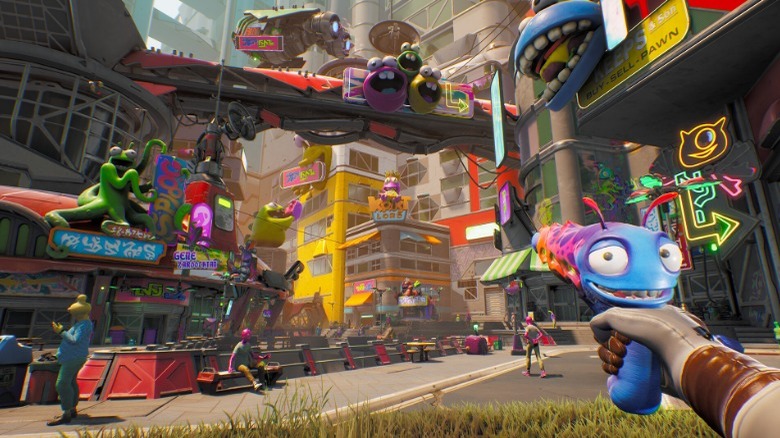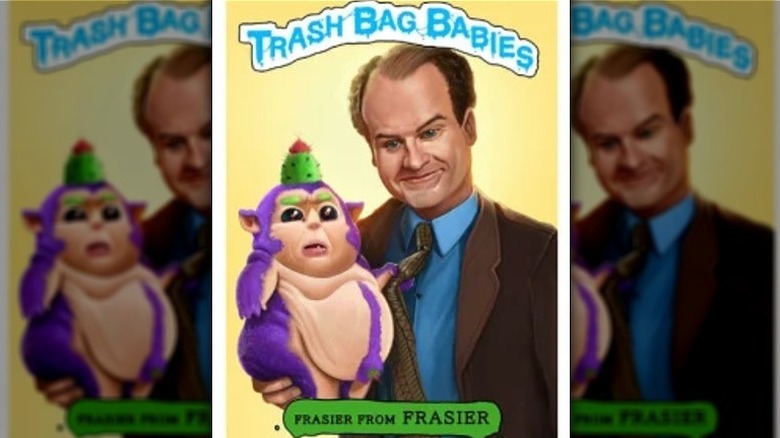Things Only Adults Notice In High On Life
The creator of "Rick and Morty" has done it again. "High on Life" is the newest title by Justin Roiland's Squanch Games. The experience transplants the studio's signature style and sense of humor into an all-new FPS, which is packed with more details and Easter eggs than you can squanch at.
Since this is a Justin Roiland production we're talking about, most references and little nuggets in "High on Life" will likely go over the heads of children. That includes the ways NPCs act and talk and the double entendres loaded into just about every scene. Even some of the facts about the game's guns are better left unsaid around small children. Then again, "High on Life" is rated "M for Mature," so it makes sense that some of this stuff just might not land for younger players. Here are all the small details we noticed in "High on Life" that children probably wouldn't.
Beware of spoilers ahead for "High on Life."
Tons of voice actors hail from Adult Swim shows
Voice actors are some of the most flexible people in the entertainment industry. Most can slip into a variety of roles in properties aimed at virtually every demographic. Did you know the voice of Baymax in "Big Hero 6" also plays the abusive, alcoholic father in "Moral Orel"? Or that the voice of Spongebob Squarepants also portrays Squanchy in "Rick and Morty?" "High on Life" is full of these kinds of versatile voices, although some actors are better known for mature roles.
Since "High on Life" is a Justin Roiland production, audiences will hear him the most. After all, he plays the game's pistol, Kenny, as well as a number of other NPCs. Roiland is also in plenty of other adult-oriented shows and games, playing characters such as Korvo in "Solar Opposites," Doug Cheston in "Invincible," and of course the titular characters in "Rick and Morty." But while Roiland has dipped into characters in shows aimed at younger audiences, including "Adventure Time," another constant voice, Michael Cusack, hasn't. In "High on Life," Cusack voices Knifey, but he also plays Alan and Pim in "Smiling Friends" and random characters in "YOLO Crystal Fantasy," neither of which are safe for children.
Other actors in "High on Life" have been in plenty of kid-friendly shows, but their most memorable roles couldn't be further from that age group. The deadly Nipulon is voiced by James Urbaniak, perhaps best known in voice acting for his role as Dr. Venture in Adult Swim's "The Venture Bros." And the NPC Gene is voiced by David Herman, who played Scruffy in "Futurama" and Kevin Crawford in "Paradise PD." Again, all shows aimed at older viewers.
Snipers surrender if you get close enough to them
What's the worst part of any FPS game? Is it regenerating health? A weapon limit? No, the answer might be snipers. Those annoying sharpshooters typically camp at the far ends of levels and take pot shots that tend to quickly dissolve shields and health bars. Usually, a player's safest bet is to beat a sniper at their own game, but "High on Life" rewards players skilled enough to sneak by.
If gamers approach sniper nests, these enemies will try their hardest to eliminate them, but in "High on Life," if players can get right in snipers' faces, they immediately raise their hands into the air and surrender. This seems like a cowardly tactic — after all, gamers in FPS titles don't usually take prisoners. But then again, it takes a special kind of player to actually sneak up on snipers in the first place.
Let's be honest: Whenever we're confronted with a sniper in video games, our first instinct is to fire back. Most players, especially younger ones, wouldn't even think of trying to sneak up on a sniper that's facing their direction. As soon as we have one in our sights, we instinctively take them out, not considering a game might reward us for being patient and waiting to see the whites of their eyes. But "High on Life" does.
What is with Gatlian biology?
Every FPS game lives and dies by its weaponry. What is the point of shooting a gun in a video game if it isn't satisfying to use or even earn? Some games go a bit further, and "High on Life" features a novel roster of organic, sentient guns called Gatlians. On one hand, this design choice gives each weapon a personality (figuratively and literally), but on the other hand, it also raises some squicky questions.
In "High on Life," Gatlians are living creatures that somehow evolved into guns. Since Gatlians are living firearms, they generate their own ammo, so you never have to worry about running out. You still have to reload them, though. Admittedly, organic guns are nothing totally new in the world of fiction, but in "High on Life," Gatlians have some... disturbing anatomical features. Of course, you need to have taken the requisite biology courses to understand most of these implications, while younger players might take these functions at face value.
Let's start with an obvious question: What orifice are Gatlians firing their projectiles out of? Since their heads face the player and their business ends face enemies, the most obvious answer is their butts. Does this mean Gatlians are projectile excreting their enemies to death? The game's final boss claims his movements are "toxic" (his words, not ours), so there's precedence for that. Also, in order to reload some Gatlians, you have to yank on or touch some...protuberances. We aren't going to directly spell these out, but given some of their reactions, let's just say you're probably not pulling their legs.
You're the alien here
Sci-fi games are full of reliable tropes, and one of those is the presence of alien lifeforms from outer space. Sometimes they visit your planet, other times you visit theirs. But are they really aliens if you're the visitor from out of town? Justin Roiland doesn't think so.
At the start of "High on Life," when the villainous G3 Cartel invades Earth, the Gatlian Kenny calls the player an "alien." And then the main antagonist calls all humans the "aliens of Earth." But aren't Kenny and the G3 invaders the aliens, since they aren't from Earth? That might be how this relationship is usually portrayed in media, but this seems like yet another example of Justin Roiland's sense of humor. It almost feels like a continuation of the "there's literally everything in space" gag from "Rick and Morty" — but it is actually a surprisingly realistic portrayal of aliens.
Little known fact of the word "alien" — its literal definition actually means "a foreigner." While the term has become shorthand in science-fiction for any non-Earth species, it would actually apply to any species from a different planet from the person using the term. Sure, Gatlians and the G3 Cartel are aliens to humans, since they don't hail from Earth, we're the aliens to their world. Furthermore, one commercial in "High on Life" features a goopy alien stating an "alien" court found him innocent of kidnapping an "alien" baby. More humor, yes, but also confirmation that every alien species considers every other planet's denizens to be aliens. Pretty heady stuff that kids might not catch onto.
Making more is just that easy
Thanks to video game logic, each Gatlian that players pick up serves a different battlefield role. Kenny is your average pistol, Gus is a shotgun, and Creature is a baby factory. No, seriously. He "attacks" by launching his nano-lifespan offspring at enemies. Things get even weirder from there.
When players meet Creature, they immediately get to use him and learn the ins and outs of his mechanics. Like every other introduction to a Gatlian, this segment serves as an expository tutorial and window into Creature's personality. He is initially sad that his children die after a few seconds, but then he claims it's "easy to make more" and "feels good" to do so. Maybe Creature is just acting irrationally because the G3 Cartel messed him up. Or maybe (definitely) it's a double entendre that only adults would get.
Virtually everyone who is old enough to play "High on Life" should know how children are made, so it's easy to see what Creature is referring to. Of course, actual pregnancy isn't as cut and dry (or instantaneous) as Creature makes it sound, but "High on Life" is a comedic video game, so we can probably cut the developers some slack.
The healing process takes time
Many games, movies, and shows touch on the subject of forgiveness, albeit in a simplified manner. Say one character, maybe a protagonist, makes a colossal mistake — then by the end of the story, they have received forgiveness or absolution with no further consequences. However, that idealistic version of events is far removed from reality. If you want a better and more mature example of how forgiveness actually works, you might be surprised to find it in "High on Life."
Partway through "High on Life," Kenny reveals that he accidentally told the G3 Cartel about the existence of his home planet, and like the mustache-twirling villains they are, they killed off 99% of the Gatlian population with a zombie virus before enslaving the rest. When Kenny comes clean to the other Gatlans, they take it about as well as you might expect, i.e., they spend the rest of the game barely resisting the urge to kill him — aside from the ever-cheerful Creature.
On one hand, it seems unfair that the Gatlians don't forgive Kenny after all the good he does to make up for his accidentally-genocidal actions. Then again, that's just how the healing process works. Ask most adults; forgiveness isn't something you can earn with just a few side quests. It's a long, nuanced, and arduous path, and in Kenny's case, not even sacrificing himself by crawling up the G3 Cartel leader's rear end to detonate a bomb (long story) eases the pain. But it's a start.
That's Just Frasier
Justin Roiland's sense of humor can be summarized in one word: Weird. Many gags in his projects rely on semi-rambling ad-libs, but he's also not immune to inserting random references. Really random, including making references to celebrities that many children wouldn't recognize, like Jan-Michael Vincent in "Rick and Morty" and Kelsey Grammer in "High on Life."
Like many modern games, "High on Life" keeps players busy with collectibles. These include "Trash Bag Babies" cards, which are a riff on the "Garbage Pail Kids" trading cards from the 80s and 90s. That's already a deep cut few kids would get, but one in-game collectible Trash Bag Baby card doesn't prominently feature one of the titular Trash Bag Babies; it's literally Frasier from the TV show "Frasier." That's the joke.
Who is Frasier, you ask? Well, kids, he was a character played by Kelsey Grammer who first appeared in the show "Cheers" and received his own TV spin-off that aired from 1993 to 2004. Neither show was aimed at children, and anyone who saw them as a kid would be an adult now. You probably wouldn't realize the collectible item rendered a real TV actor unless you were around to watch it back in the day. A truly bizarre reference in a game full of them.

